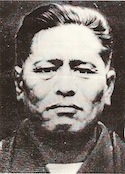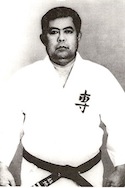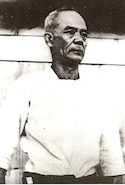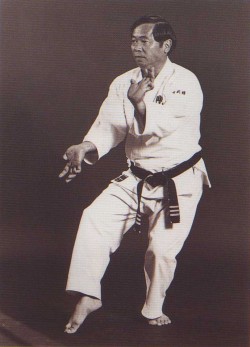History
Origin of Karate
Karate (empty hand) originated in Okinawa, Japan approximately 700~1000 years ago during the Samurai era. The exact date is uncertain, since written records did not exist at those times. This art form evolved into three different styles, reflecting the three major cities on the island which were Naha, Shuri and Tomari. The different styles of Karate that emerged were named after the city it was practiced in: Naha-te, Shuri-te and Tomari-te.
|
Origin of Goju-ryu: Kanryo Higaonna (1853-1917) went to China and learned Crane style from Ru Ru Ko. This knowledge was passed on to his student Chojun Miyagi (1888-1953) who later named it “Goju-ryu”. This was taught to Sekou Higa (1898-1966) who passed on the style to Seiko Fukuchi (1919-1975). |
 Sensei Chojun Miyagi |
 Sensei Seiko Fukuchi |
 Sensei Seiyu Nakasone |
Origin of Tomari-te: Yoshitaka Uku (1800-1850) and Teruya (1804-1864) both taught Tomari-te style to Kousaku Matsumura (1829-1898). This then was passed onto Koutatsu Iha (1873-1928) who then taught Seiyu Nakasone. |
|
Origin of Gohaku: Seiyu Nakasone was the teacher of Iken Tokashiki, who, after learning the Tomari-te style, later practiced Goju-ryu style under Seiko Fukuchi. At this time Fukuchi developed the “Senbukai” association of Goju-ryu. When both Nakasone and Fukuchi passed away, Tokashiki took it upon himself to merge the two styles in honour of his teachers. His teachers were of “Bushido,” therefore there was great honour in what they practiced. In order to respect this tradition, Goju-ryu and Tomarite became Gohaku. A new association, Gohakukai was created and in 1982 was recognized as part of the Okinawan Karatedo Association. |
 Sensei Iken Tokashiki |
|
Philosophy of Gohakukai Related to the traditions of Okinawa, Gohakukai emphasizes all aspects of respect not only shown towards others but also to yourself. This style is not solely based on the growth of physical strength, but rather a balance must be achieved mentally and physically. The physical aspect is attained through the practice of personal techniques and Kata which results in physical growth and health. However with the progression of the physical practice, the mental balance will be achieved through the realization of Gohakukai –Karatedo as an art form. By obtaining this balance, the ability to fully understand respect will be achieved, and attaining the capability to learn and teach others will be acquired. By students achieving this balance and understanding, the spread of Gohakukai internationally will be maintained as a pure, traditional Okinawan art form. Therefore the traditional style will be preserved throughout future generations worldwide. |